It’s the most wonderful (if most expensive) time of the year. Wine Lister Value Picks help you to avoid compromise on your seasonal drinking choices, identifying wines and vintages with the best quality-to-price ratios. This week’s top five looks at some affordable options for you – still with impressive Quality scores – complete with two Ports in the mix to keep us feeling festive. With Italy and Portugal sharing the top five (and even the top 10) red Value Picks by Quality score, Wine Lister’s Christmas drinking picks stick firmly to Mediterranean climes.
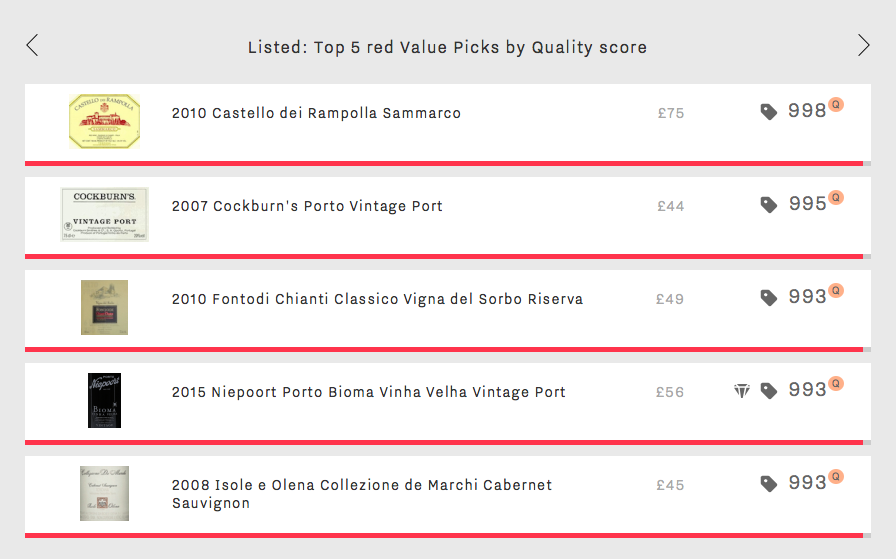
In first place is Castello dei Rampolla Sammarco 2010. Although it is this week’s most expensive option (at £75 per bottle in-bond* vs. an average £49 of the four other wines of this top five) the spectacular Quality score of 998 is impossible to ignore. Indeed, it earns the highest Quality score of any 2010 red on Wine Lister, alongside three others – Castello dei Rampolla’s Alceo, Cerbaiona Brunello di Montalcino, and Vietti Barolo Ravera – all of which are at least £71 more expensive. Sammarco 2010’s remarkable Quality score is due a perfect score of 100/100 from Vinous’ Antonio Galloni, who describes it as “stunning” and “magnificent”.
Next is this week’s first port – Cockburn’s Vintage Port 2007. With a Quality score of 995 and price of £44 there can be no doubt about its status as a Value Pick. It has just entered its drinking window, and with a predicted wine life of 53 years, it could make for the perfect Christmas gift (if you can refrain from drinking it yourself).
The group’s second port, Niepoort Bioma Vinha Velha Vintage Port 2015, shares a Quality score of 993 with the last three spots of this week’s top five. It is the only one of this week’s Value Picks also to achieve Hidden Gem status – Wine Lister’s Indicator for excellent wines that are yet to receive proper recognition. Although it will not be ready to drink until 2028, at £56 per bottle this is an exceptional value wine to store away for Christmases to come.
Rounding out this week’s top five in Tuscan triumph are Fontodi’s Chianti Classico Vigna del Sorbo 2010 and Isole e Olena’s Collezione de Marchi Cabernet Sauvignon 2008. They have both just entered their drinking windows, but will last for many years to come. Each earning a Quality score of 993, their modest prices of £49 and £44 per bottle respectively provide fantastic value.
All that remains is to wish you a very Merry Christmas.
*Prices shown assume the purchase of a whole case. See more on pricing on our website.
While Bordeaux may be best-known for its red blends, many a left-bank cru classé also produces a dry white, particularly in Pessac-Léognan. This week we examine the five most expensive dry white Bordeaux wines.
Whilst each of the five frequently stands in the shadow of their red counterpart (or flagship sweet white in the case of Y d’Yquem), their average price is in fact 28% higher (£260 vs £203). This is presumably due to the dry whites being produced in considerably smaller volumes than their red/sweet white counterpart (just 10% on average).
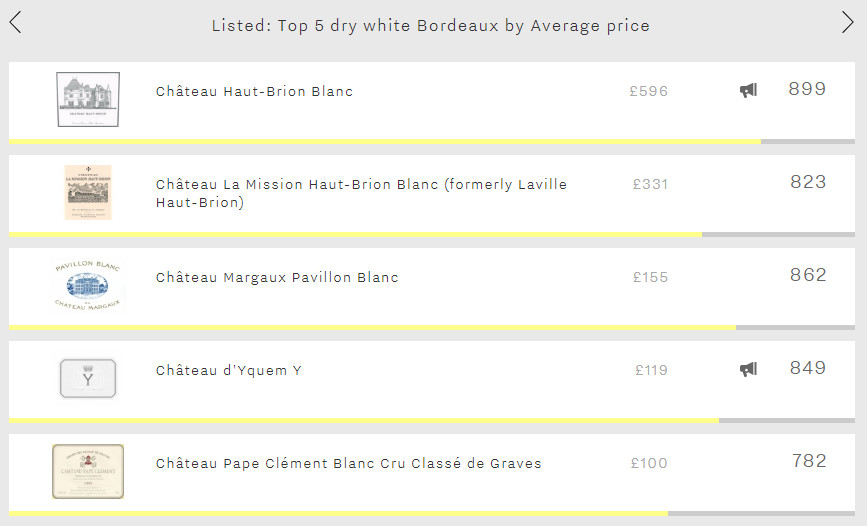
Leading the way is Haut-Brion Blanc at a cool £596 per bottle in-bond, 78% more expensive than Bordeaux’s second-most expensive dry white – its neighbour La Mission Haut-Brion Blanc – and well over three times the average price of the remaining wines in this week’s top five. Whilst its very low production, almost identical to La Mission Haut-Brion Blanc’s and thus the joint-lowest of the five, undoubtedly plays a part in its high price, the fact that it achieves the group’s best Quality and Economics scores (923 and 890 respectively) will also be a contributing factor. Aside from high ratings from each of Wine Lister’s partner critics, its excellent Quality score is also thanks to an average wine life of 10.3 years – the longest of all dry Bordeaux whites on Wine Lister. Indeed, the 2014 vintage, Haut Brion Blanc’s best ever with a Quality score of 975, “should drink well for years and perhaps even decades to come”, according to Antonio Galloni.
Next comes La Mission Haut-Brion Blanc at £331 per bottle in-bond. Relabelled in 2009, this was formerly Laville Haut-Brion. The 2011 is its best vintage since its relabelling, achieving an outstanding Quality score of 974, with Jancis Robinson – who tends to award it her highest scores of the group – calling it “one of the best Bordeaux 2011s”.
In third place is Margaux Pavillon Blanc (£155 per bottle in-bond). Whilst still priced considerably below the whites from Haut-Brion and La Mission Haut-Brion, it is closing the gap, courtesy of vastly stronger growth rates, with a three-year compound annual growth rate of 18% and having added 6% to its value since May. Over both the long and short-term, the two Pessac-Léognan whites have each grown at under half the rate of Pavillon Blanc.
Y d’Yquem is Bordeaux’s fourth most-expensive dry white, at an average price of £119 per bottle in-bond. Boosted by the immense clout of the château’s flagship sweet wine – which enjoys the joint-best Brand score of any wine on Wine Lister (999) – it has the strongest brand of this week’s top five (894). It does so thanks to featuring in the greatest number of the world’s best restaurants of the group (15%), just managing to nudge ahead of Haut-Brion Blanc (12%).
We return to Pessac-Léognan for Bordeaux’s fifth most-expensive dry white, Pape Clément Blanc (£100 per bottle in-bond). The 2017 was its best ever vintage, achieving an excellent Quality score of 903. Whilst it wasn’t quite able to match the scores of Haut-Brion and La Mission Haut-Brion (931 and 939 respectively), it represents considerably better value. At £100 per bottle, it is around one fifth the price of its Pessac-Léognan rivals.
Thanks to tiny production quantities, exceptional quality, and increasing popularity, Burgundy tends to be expensive. In Wine Lister’s Burgundy Market Study (published in January this year), we analysed its rapidly-climbing prices. This week’s Listed blog focuses on the very tip of the Burgundy price hierarchy, with the top five by average price.
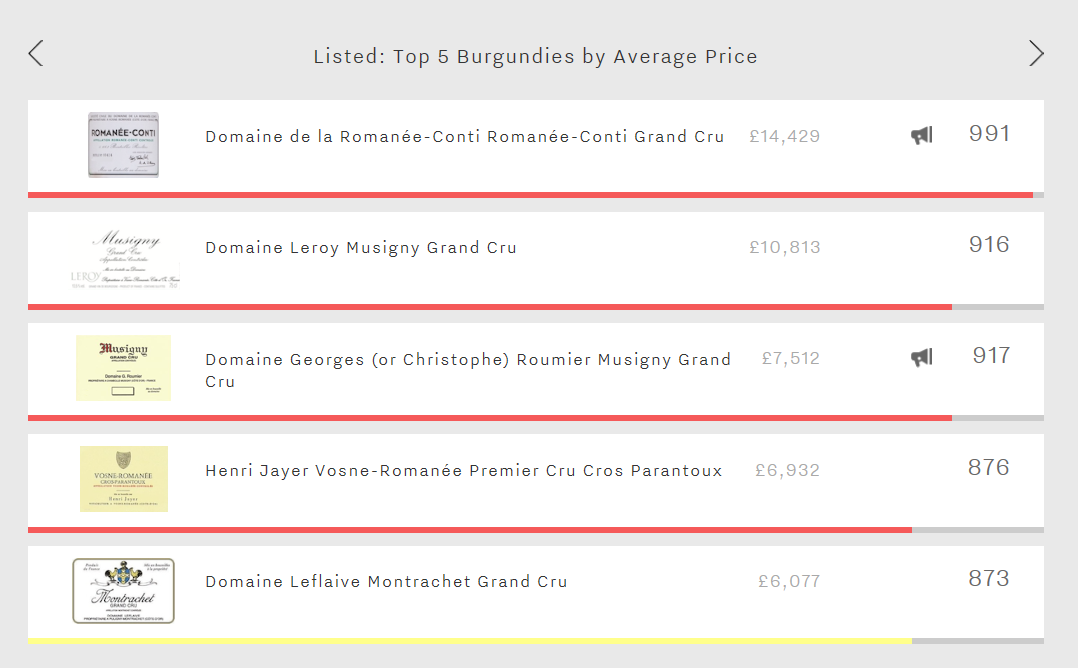
Four of this week’s top five hail from the Côte de Nuits, the first of which is, unsurprisingly, Domaine de la Romanée-Conti’s Romanée-Conti at an average price of £14,429 per bottle in-bond. The high price tag is accompanied by the best red Quality score on Wine Lister (993) and a Brand score of 989. The latter is achieved in part by being the 8th most-searched-for wine on Wine Lister (and indeed gains two and a half times as many monthly searches on Wine Searcher as the remaining wines of this week’s top five combined). Its most recent release – the 2015 vintage, receives a Quality score of 997, with Wine Lister partner critics Bettane + Desseauve and Jancis Robinson both awarding it 20/20. Even if the 2015 vintage is DRC Romanée-Conti’s best-performing in the last 15 years, its price increase of nearly 500% (from £2,925 to £17,496) since release in January is virtually incomprehensible.
In second place is one of two Musignys to feature this week. Domaine Leroy’s Musigny has an average in-bond price of £10,813 per bottle and a Quality score of 988 – just five points behind this week’s number one. Its overall Wine Lister score sits 75 points down from DRC Romanée-Conti, due to a more modest Brand score of 781. Interestingly, Leroy’s Musigny has been qualitatively more consistent over the past five releases than Wine Lister’s highest-quality red – its Quality score deviates a maximum of just one point from year to year since 2010 (compared to DRC Romanée-Conti’s maximum deviation of seven points).
Number three of this week’s top five is the second Musigny, this time from Domaine Georges Roumier. With a slightly lower price tag of £7,512 per bottle in-bond, and the second-highest Brand score of the group, Roumier is somewhat a darling of the trade – indeed, this Musigny is in the top 10% of most talked-about wines by the fine wine trade, according to Wine Lister’s Founding Member Surveys.
The last two spots are taken by wines that each stand alone among this week’s top five for their own reasons. The first, Henri Jayer’s Vosne-Romanée Cros Parantoux at £6,932 per bottle is the only Premier Cru to feature, as well as the only wine no longer in production.
Finally, Domaine Leflaive’s Montrachet Grand Cru is the only white of the group. As the most expensive white Burgundy on Wine Lister at £6,077 per bottle, it also earns white Burgundy’s highest Quality score of 985.
To many wine collectors, the king of Italian wine is Barolo. Its popularity, particularly for older vintages, continues to grow (as proven in our latest restaurant presence analysis). However, the Piedmont sovereign’s Tuscan counterpart – Brunello – should not be overlooked. This week’s top five looks at the best Brunellos by Quality score – and all five achieve scores above 900.
Perhaps unsurprisingly, the top five Barolos by Quality score achieve an average score 34 points higher than this week’s Brunello group (964 vs 929). However, couple this with the fact that the Brunellos tend to cost nearly half as much as their Barolo counterparts (£142 vs £275), and Brunello’s value starts to become clear.
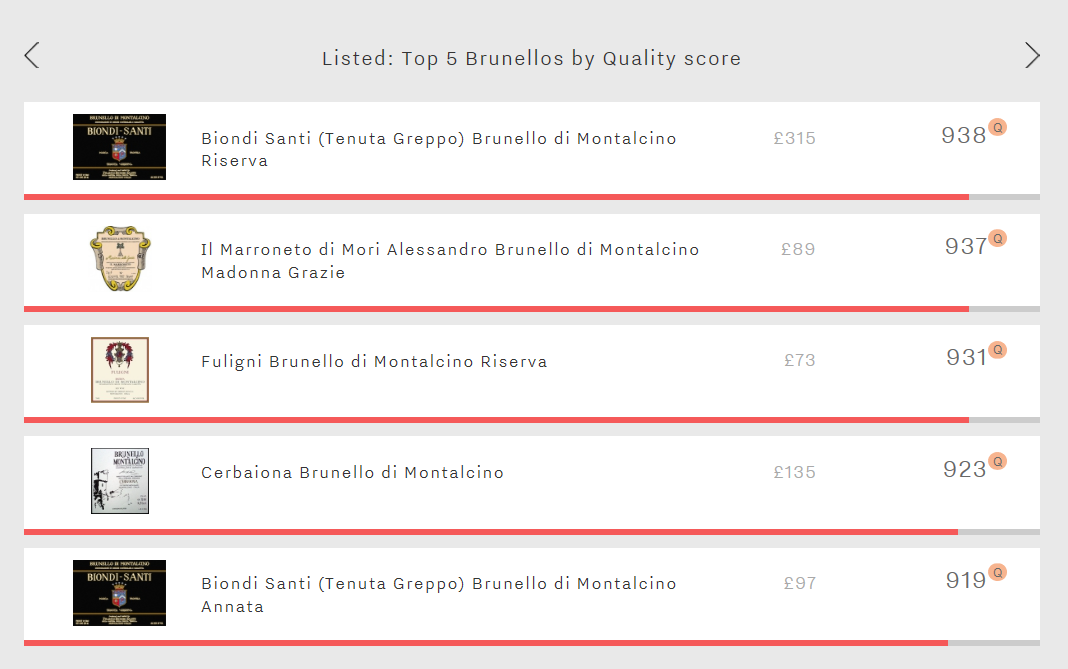
Biondi Santi earns two spots in this week’s top five, with its Brunello Riserva and Brunello Annata bookending the group. The former wins this week’s battle with an impressive Quality score of 938. It also achieves this week’s highest Economics score (941), contributing to its excellent overall Wine Lister score of 926 – also the best of the group. Although, at £315 a bottle it is also more than three times as expensive as the collective average price of the other four (£99).
In second place this week is Il Marroneto di Mori Alessandro Brunello Madonna Grazie. With a Quality score of 937 it is just one point behind this week’s number one – the slightly lower score being due to its shorter average ageing potential (12 vs 19 years). Its 2008 vintage provides the most impressive quality to price ratio of this week’s top five, achieving a Quality score of 938, yet available for as little as £45 per bottle in-bond.
Next in this week’s top five is Fuligni Brunello Riserva with a Quality score of 931. It appears to be the least well-known of the group, with a Brand score of 645. This is down to presence in just 5% of the world’s best restaurants, and being ranked 1,257th for monthly online searches of all Wine Lister’s wines on Wine Searcher. Its relatively modest Brand score could perhaps be the reason for its average price being the least expensive of the group (£73 per bottle).
Cerbaiona’s Brunello takes fourth place, with a Quality score of 923. Though not earning the highest Brand score of this week’s top five, it is still a Brand to watch – Cerbaiona was the only Brunello to feature in both recent top 20 lists for horizontal and vertical restaurant presence gains. Perhaps its increasing popularity is in part thanks to such an impressive score for the 2010 vintage. Vinous awards it 100 points, singing its praises: “The most anticipated wine of the night, the Cerbaiona shows why it belongs in the pantheon of the most epic wines ever made in Montalcino. A Brunello with no beginning and no end, the 2010 Cerbaiona just is. Every aroma, every shade of nuance, every texture is just…perfect.”
Last but not least is Biondi Santi’s Brunello Annata with a Quality score of 919. Though in fifth place for Quality, it achieves the highest Brand score of this week’s top five, at 934. This impressive Brand score is the result of great restaurant presence (17%) and being the 118th most searched-for wine on Wine Lister.
A glass of cold Riesling on a hot summer’s day hits that sweet spot between refreshment, satisfaction, and intrigue. Any one of Germany’s finest wines for Quality under £300 would definitely deliver those three things. Moreover, with an average drinking window of 16 years, and with global warming seemingly set to deliver increasingly high summer temperatures, stock up on them now and you will be rewarded with stunning wines for years to come.

It is perhaps revealing of Riesling’s under-the-radar nature that three of this week’s top five qualify as Hidden Gems, meaning that they combine excellent critics’ ratings with modest restaurant presence and online popularity. Moreover, many of Wine Lister’s Hidden Gems were picked out by the global fine wine trade in our Founding Members’ survey, underlining the perennial mystery of Riesling as the darling of the trade, despite struggling to spark wide-scale consumer demand. Interestingly the group’s three Hidden Gems are all Beerenausleses (BAs). Schloss Johannisberg Rosa-Goldlack, Fritz Haag Brauneberger Juffer Sonnenuhr, and Weingut Robert Weil Kiedricher Gräfenberg’s BAs, in spite of a phenomenal average Quality score of 969, achieve an average Brand score of just 398 – the result of being present in just 2% of the world’s top restaurants and receiving only 70 online searches each month on average. Demand for excellent sweet Riesling is clearly not there at present.
However, returning to the group’s fantastic quality, it is Egon Müller’s Scharzhofberger Riesling Auslese that comes out on top with a score of 974. 2014 was its best ever vintage, with one of JancisRobinson.com’s critics, Michael Schmidt, awarding it 19/20 and heaping on the praise: “Our sensory perception is treated to an animating exuberance of exotic fruit and fresh raisins. Botrytis has been kept in check to focus on purity of expression rather than indulge in unctuous combustion”.
The group’s final spot is filled by Keller Westhofen Abtserde Riesling Grosses Gewächs (966). It is Jancis Robinson’s favourite of the five, achieving an outstanding average rating of 18.5/20 from Wine Lister’s UK partner critic. Tellingly, particularly in the context of the three BA’s lack of consumer demand, it is also the group’s most popular wine, receiving nearly 30 times more searches each month on average than the BAs. Consumers appear much more at ease with Riesling’s dryer styles.
Our in-depth study of Burgundy earlier this year showed that its prices continue to rise at a faster pace than those of any other fine wine region. With such high prices and tiny availability, wine buyers seeking good value drinking wines may often find their cellar a little light on Burgundy.
However, alongside the virtually unattainable wines at the most prestigious end of the Burgundy scale, there are some Value Picks to be found.
One of four Wine Lister Indicators, Value Picks are wines with the best quality to price ratios. Wine Lister’s proprietary Value Pick algorithm allows more expensive wines with exceptional quality to shine by reducing the impact of price in calculating the ratio.
The simple answer to good value for white Burgundy is Chablis.
For exceptional value at everyday drinking level in particular, Domaine William Fèvre stands out. Seven out of the last eight vintages of the domaine’s straight Chablis are identified as Value Picks, with prices per bottle under £13 and an average Quality score of 553 (above average on Wine Lister’s 1000-point scale).
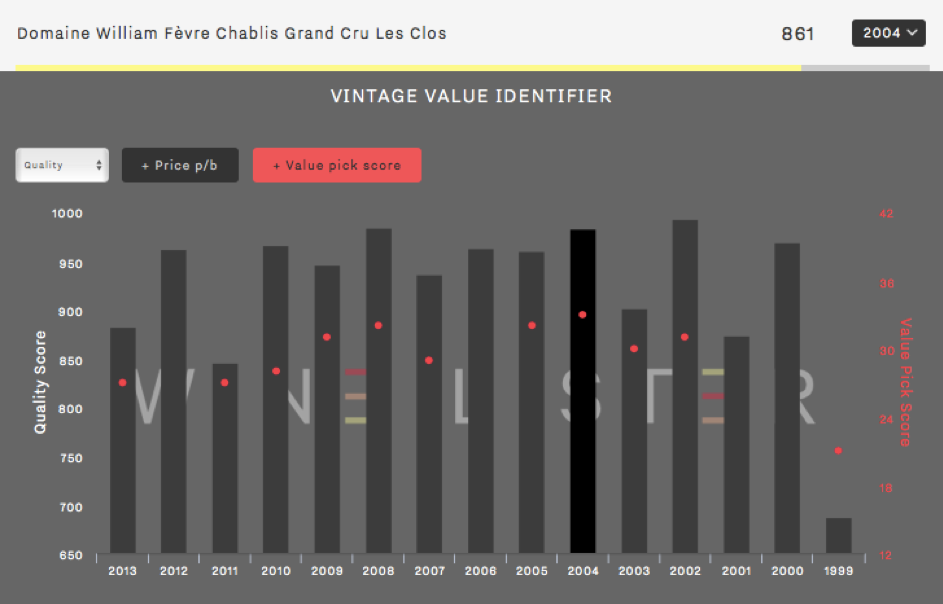
Moving up the price ladder, Domaine William Fèvre’s Chablis Grand Crus Les Clos 2004 shows exceptional value, with a price per bottle of £50 and a Quality score of 982 – shown in the Vintage Value Identifier chart above. At a comparative score (979) for white burgundy in 2004 we find Domaine Leroy’s Corton-Charlemagne Grand Cru, with a price tag 60 times higher – £3,005 per bottle.
Chablis make up all top 10 white Burgundy Value Picks.
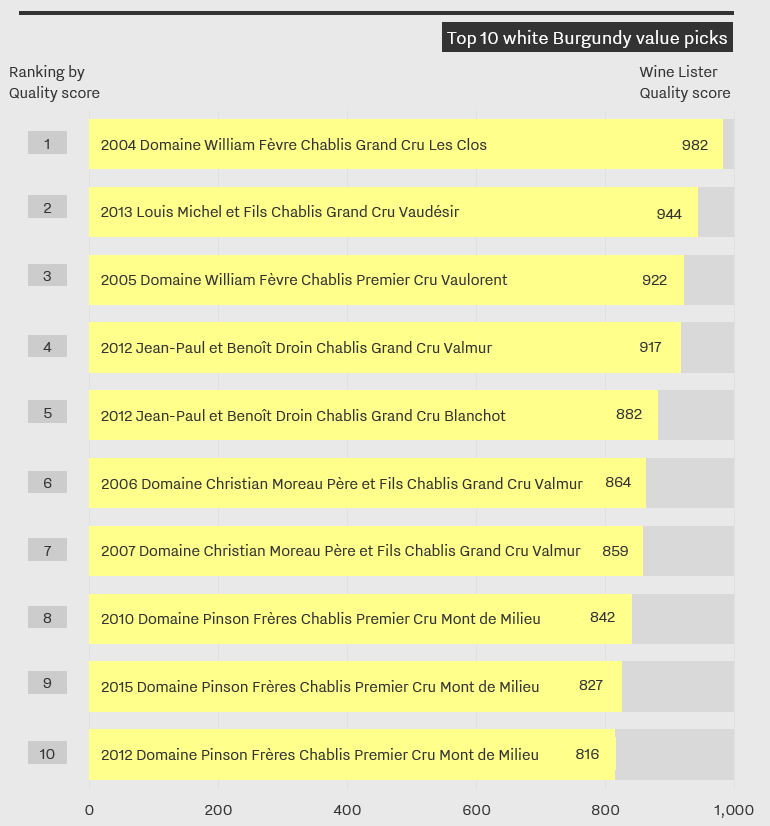
The Burgundian Value Pick with the highest Quality score is in fact a red – Domaine de la Pousse d’Or’s Volnay Premier Cru Clos de la Bousse d’Or 1995. At c.£50 per bottle and a Quality score of 983, it earns the highest Quality score for Volnay, and the third-highest for Burgundy’s 1995 vintage (after Méo-Camuzet’s Vosne Romanée Cros Parantoux and Rousseau’s Chambertin Grand Cru, priced at £1,046 and £1,448 respectively). Any lucky owners of the Clos de la Bousse d’Or 1995 should open and enjoy it now. Wine Lister partner critic, Jancis Robinson, puts its drinking window between 2006 and 2019.
The majority of Antonio Galloni’s Bordeaux 2017 scores have been added to Wine Lister. The release of his Saint-Emilion satellites will complete Vinous’ coverage of Bordeaux en primeur 2017. Below is an overview of his top-scoring wines so far for this vintage:
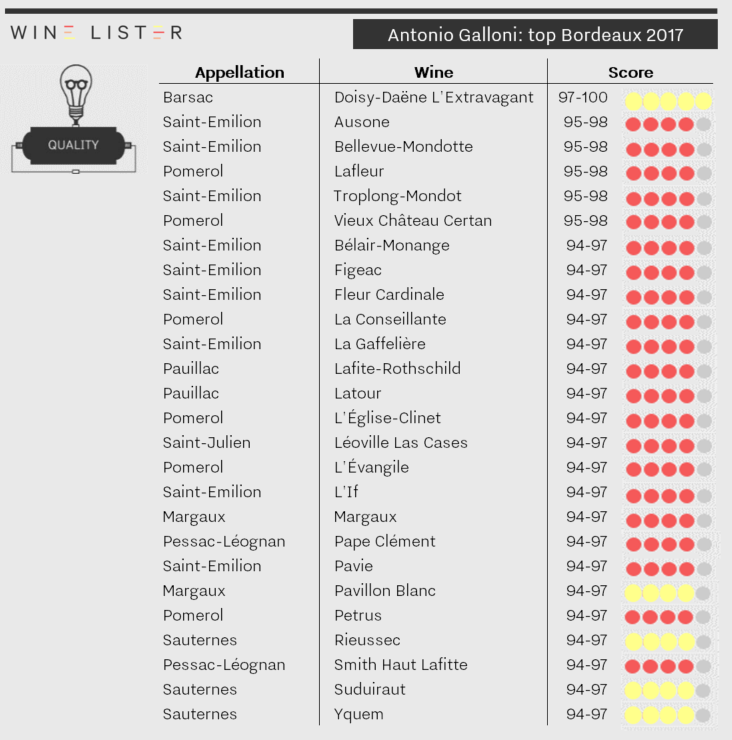
The only potential perfect scorer is Doisy-Daëne L’Extravagant (97-100). This strengthens the case for the Sauternes & Barsac appellations as the biggest successes of the 2017 vintage (see top scores from Bettane+Desseauve, Jancis Robinson and Neal Martin for comparison).
Five wines scored 95-98 points, and they are all from the right bank, which Galloni explicitly declares to be superior to the left bank in 2017. Lafleur, released today exclusively by Justerini & Brooks, achieves the top score bracket for a red wine from all four of Wine Lister’s partner critics, making it the red wine of the vintage.
It is joined at the top of Galloni’s picks by Ausone, Bellevue-Mondotte, Troplong-Mondot, and Vieux Château Certan.
The next score category, 94-97, is also dominated by the right bank, featuring 10 wines from Saint-Emilion or Pomerol and just six red wines from across the whole of the Médoc and Graves. The surprise entry is L’If, from the Thienpont family, which outscores its venerable older sibling, Le Pin (93-96).
Three left bank first growths make the cut: Lafite, Latour, and Margaux. Alongside its big brother, Pavillon Blanc is Galloni’s top scoring dry white 2017, also achieving 94-97 points.
Other wines scoring 94-97 from Antonio Galloni include: Bélair-Monange, Figeac, Fleur Cardinale, La Conseillante, La Gaffelière, L’Église-Clinet, Léoville Las Cases, L’Évangile, Pape Clément, Pavie, Petrus, Rieussec, Smith Haut Lafitte, Suduiraut, and Yquem.
All these scores are now live on the wine pages of our website for subscribers to view (alongside those of Bettane+Desseauve, Julia Harding MW and Neal Martin), with links through to Antonio Galloni’s tasting notes on Vinous.com. Have a look at Antonio Galloni’s coverage of Bordeaux 2017 here. NB. As Jeannie Cho-Lee did not taste the 2017 Bordeaux, Antonio Galloni’s scores complete Wine Lister’s Quality scores for the vintage.
Bordeaux 2017 en primeur scores are now out from Neal Martin for Vinous.com – our US partner critic, and one of the most prominent voices of international wine criticism today. (Antonio Galloni’s scores are due out this Thursday, 3rd May). This is the first time Wine Lister has featured Neal Martin’s scores after he joined Vinous in February this year. Below are his scores equal to or above 94-96:
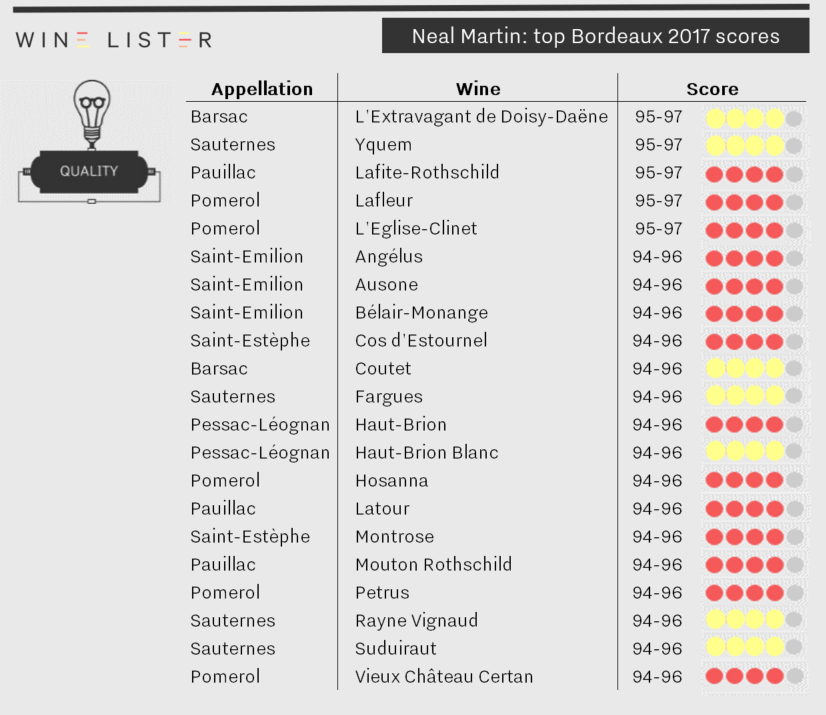
No wines earned perfect scores this year (in contrast with 2016, where Martin awarded a potential 100 points to eight wines), with five wines achieving Martin’s highest potential score of 97.
With a score of 95-97, Yquem sits in the top score bracket for the third time, already awarded 18.5 and 19.5-20 by Julia Harding MW (on behalf of Jancis Robinson) and Bettane+Desseauve respectively.
Similarly to Bettane+Desseauve, Martin’s appreciation for the quality of Sauternes and Barsac in 2017 is clear, with five other sweet whites making his top 21 (L’Extravagant de Doisy-Daëne, Coutet, de Fargues, Rayne Vignaud, and Suduiraut).
Lafite is Martin’s highest scoring Médoc first growth, which he describes as “classic from start to finish”. Joining the high rankings are first growths Haut-Brion (and its white), Latour, and Mouton, all earning 94-96 points.
The right bank figures strongly too. Two Pomerols (Lafleur and L’Eglise-Clinet) equal Lafite’s score, with three more earning 94-96, alongside three wines from Saint-Emilion. Ausone, like Yquem, makes its third appearance in top scores for Bordeaux 2017 from Wine Lister partner critics. “What a great Ausone this is destined to be,” comments Martin.
Bélair-Monange is perhaps the stand-out entry, described by Martin as, “the jewel in the crown of J-P Moueix… an assured, and bewitching Saint-Emilion”.
Other wines scoring 94-96 from Neal Martin include: Angélus, Cos d’Estournel, Hosanna, Montrose, Petrus, and Vieux Château Certan.
All these scores are now live on the wine pages of our website for subscribers to view (alongside those of Bettane+Desseauve and Julia Harding), with links through to Neal Martin’s tasting notes on Vinous.com. Read Neal Martin’s coverage of Bordeaux 2017 here.
Vinous coverage will be completed by Antonio Galloni’s scores, due for release on Thursday 3rd May.
Bettane+Desseauve – Wine Lister’s French partner critics – have released their en primeur scores for the 2017 Bordeaux vintage. Here is a glimpse of their top-scoring wines:
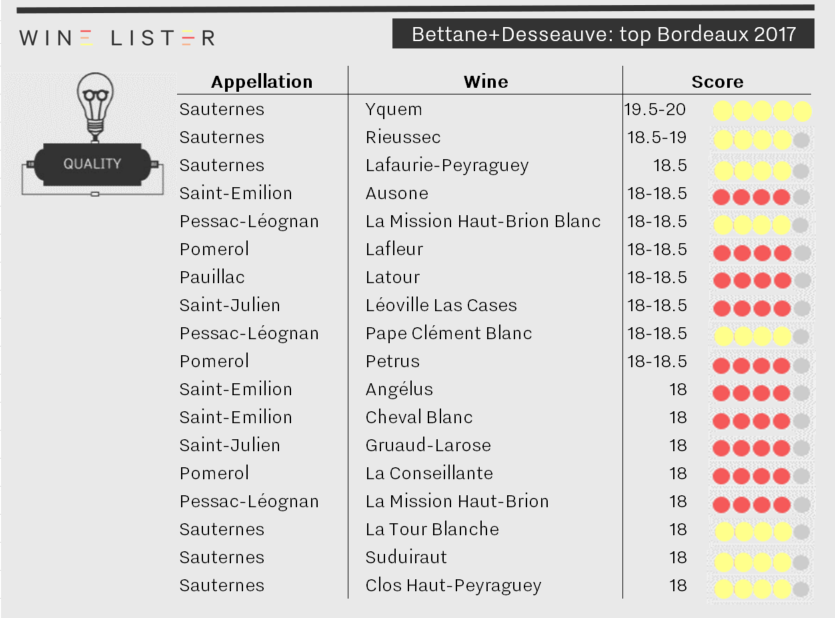
Château d’Yquem is the only potentially perfect wine of the vintage for the French duo. “Another legend ending in 7, worthy of the 1967, but more pure, and the sublime 1937 and 1947 too,” muses the encyclopaedic Michel Bettane.
Yquem was the only white wine to make an appearance in Bettane+Desseauve’s top 2016 Bordeaux, but this year has been joined by a host of other Sauternes (Rieussec, Lafaurie-Peyraguey, La Tour Blanche, Suduiraut, and Clos Haut-Peyraguey), in a vintage which Bettane has marked out as “favourable for the entire Haut-Sauternes sector”.
Two dry whites also broke the 18-point mark: La Mission Haut-Brion Blanc and Pape-Clément Blanc, painting the top of the scoreboard unprecedentedly yellow.
As for reds, taking more of a backseat than usual, the right bank dominates, with three out of the four Saint-Emilion Grands Crus Classés A scoring 18 (Angélus and Cheval Blanc) or above (Ausone). By contrast only one Médoc first growth – Latour – reaches the 18-point mark.
Joining Ausone and Latour with 18-18.5 are Lafleur, Léoville Las Cases, and Petrus. Our CEO, Ella, tasted Petrus twice – first for a sneak preview with Thierry Desseauve and her father, and then with the Wine Lister team three days later. She is not surprised to see it come out among the top five reds of the vintage, and it must run in the family, because Petrus was also Pa Lister’s favourite.
Bettane+Desseauve’s top table sees standout scores of 18 apiece granted to La Conseillante and Gruaud-Larose. And that in a year where fewer high scores were given in general; 16 2016s scored a straight 19 or above last year, compared to just one in 2017.
Today marks the close of a busy week of Burgundy 2016 en primeur tastings, with offer prices largely stable on 2015 despite tiny volumes, thanks to the more generous 2017 in the wings. However, prices have been escalating in the secondary market for several years now, with eight of the region’s top wines averaging more than £3,000 per bottle). Eyewatering, yes, but as illustrated in our recently published study, the majority of the region’s top wines are priced between £100 and £500.
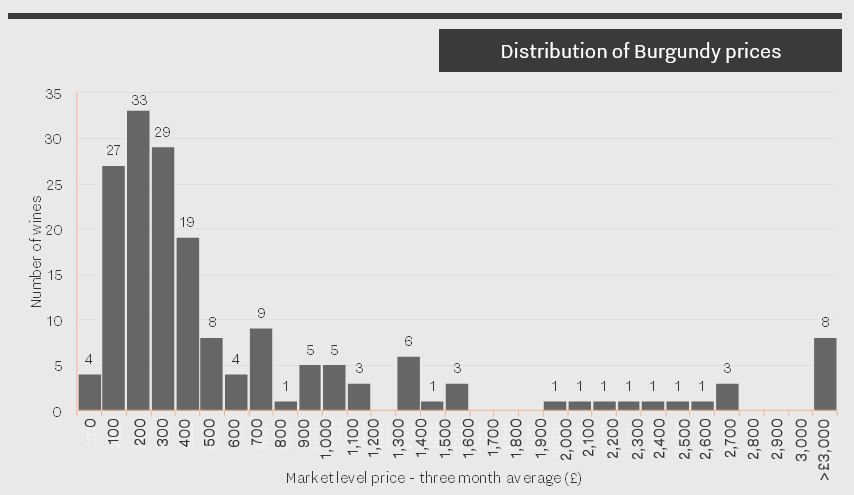
To mark this week’s Burgundy en primeur tastings, the latest Listed section picks out the top five red Burgundies priced under £300 per bottle by Wine Lister score. With an outstanding average score of 913 – putting them amongst the very strongest on Wine Lister – and four of the five achieving Buzz Brand status, these wines are worth the price tag.
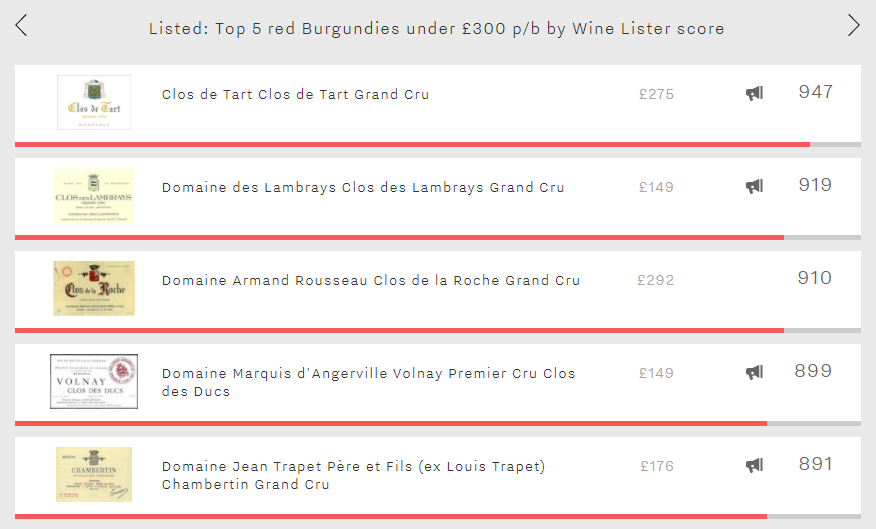
Leading the way is Grand Cru monopole Clos de Tart with a score of 947. Recently acquired by Artemis Domaines – Latour owner François Pinault’s holding company – it achieves the best Brand and Economics scores of the group (956 and 964 respectively), and is just pipped into second place in the Quality category by Trapet Père et Fils Chambertin Grand Cru (932 vs 940). Its price has increased 9% over the past six months, and now at £275, it looks like it won’t qualify for this group much longer!
Next comes Domaine des Lambrays Clos des Lambrays – part of LVMH’s portfolio since 2014 – with a score of 919. Alongside Marquis d’Angerville Volnay Premier Cru Clos des Ducs, this is the cheapest (or least expensive) of the group (c.£150 each). It enjoys its best score in the Brand category, with the group’s highest level of restaurant presence (25%), and the second-best average monthly online search frequency (5,079).
In third place is Rousseau’s Clos de la Roche Grand Cru with a score of 910. At almost £300 per bottle, it is the most expensive of the group, contributing to its boasting the best score in the Economics category (937). It is also partner critic Jeannie Cho Lee’s favourite wine of the group; she awards it a score of 95/100 on average.
Dropping just below the 900-point mark are Marquis d’Angerville Volnay Premier Cru Clos des Ducs and Trapet Père et Fils Chambertin Grand Cru (899 and 891 points respectively). They display very different profiles. The latter leads the Quality category, with the former lagging 60 points behind (still with a very strong score of 879). However,Trapet’s Chambertin struggles in other categories, with the group’s lowest scores for Brand and Economics (867 and 823). Meanwhile, thanks to the group’s strongest long and short-term growth rates, Marquis d’Angerville’s Volnay Clos des Ducs enjoys an excellent Economics score (939) – the second-best of the five.
If you’d like to discover more about Burgundy and its top wines, then click here if you are a subscriber to view the full regional study, or here to see a preview if you haven’t yet subscribed.











